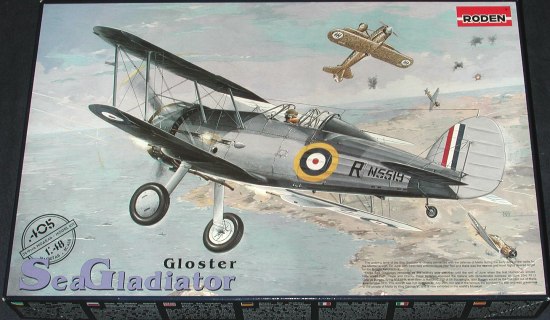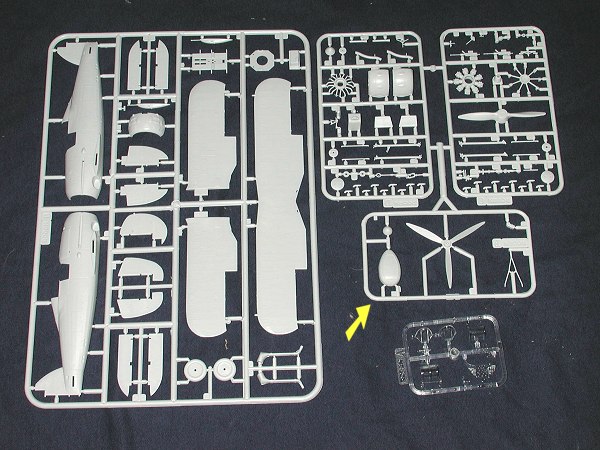
|
KIT: |
Roden 1/48 Sea Gladiator |
|
KIT # |
405 |
|
PRICE: |
$27.98 ($24.97 at Squadron) |
|
DECALS: |
Eight aircraft |
|
REVIEWER: |
|
|
NOTES: |

|
HISTORY |
|
THE KIT |

This is more of an update than a real preview. All that was said about the kit in the earlier preview and build article is the same for this one. What is different about it is that there are the bits to do a Sea Gladiator. This is all on a single sprue shown next to the arrow. It is basically the dingy pack, three bladed prop, spinner and the arresting hook.
 There are also a bunch of
different decal options included with the kit. The decals are superbly printed,
but I must confess that the blue looks too light; more like a 20s or 30's blue
than those colors used during the war. However, I'm not an expert on RAF colors
so I'll let others debate that. In any case, there are aftermarket decals out
for this kit so finding something that interests you shouldn't be too difficult.
There are also a bunch of
different decal options included with the kit. The decals are superbly printed,
but I must confess that the blue looks too light; more like a 20s or 30's blue
than those colors used during the war. However, I'm not an expert on RAF colors
so I'll let others debate that. In any case, there are aftermarket decals out
for this kit so finding something that interests you shouldn't be too difficult.
Here's what's included. First is the box art plane from Malta in June 1940. This plane is preserved in Malta according to the box top. I'll leave the color interpretations to you as the paints given are a bit generic (like Matte Green, Matt Blue Grey over Light Sea Grey). There is a rather complicated shadow-shaded scheme for biplanes. I recommend a good reference on the plane. You can find a couple of them in the book reviews section. Next is a 261 Sq plane, also at Malta but in Sept 1941. These first two have no dinghy pack nor tail hook. From 813 Sq on the HMS Eagle in AUg 1940 is next, followed by a similar plane from July of that year. The images show that the two bladed wooden prop is optional. Interestingly, the metal three bladed prop was often replaced by the wooden one as many preferred it. Rounding out all the similarly painted planes is an 804 Sq aircraft from July 1940.
Next is an all black 804 Sq plane from Scapa Flow in April 1940. I have to assume it is a night fighter. The last two are in typical camo. First is yet another 804 Sq plane from May 1940 and the last one is also from 804 Sq about the same time. Each of these various planes has some small difference in markings or has a bit of artwork on it.
As with the previous Roden Gladiator, the instructions are superb with an excellent rigging diagram.
|
CONCLUSIONS |
I think you'll be very happy with this kit. It is modern and while there have been some comments on the engine cowling, I don't think that it is that much of a problem and should result in a superb model.
You can find this kit and many others at

If you would like your product reviewed fairly and quickly by a site that has 200,000 visitors a month, please contact me or see other details in the Note to Contributors.